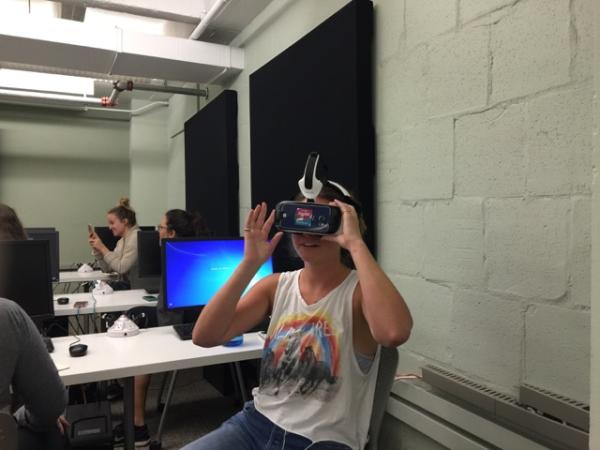The Future is Here: VR Comes to UTSOA

The School of Architecture prides itself on providing students with an education rooted in tradition. With a heavy focus on design, and studios that emphasize hand drawing and modeling, UTSOA has a time-honored curriculum that truly sets us apart. At the same time, our leadership and faculty have always embraced tools that advance design education and the field at large. Beginning with the Texas Rangers in the 1950s, UTSOA faculty have been early adopters of new modes of thinking and technology.
Last semester, the school began integrating virtual reality (VR) into select courses. This exciting new tool allows students to engage with their designs in unprecedented ways.
Robert Stepnoski, Senior Software Developer-Analyst at UTSOA, has been instrumental in incorporating VR into our curriculum. We asked him a few questions to learn more:
What exactly is virtual reality?
Wikipedia defines it thusly: VR (Virtual Reality) is computer technology that replicates an environment, real or imagined, and simulates a user’s physical presence and environment to allow for interaction. Everyone has a different reaction to VR and will be able to understand the environment to different extents. Full submersion into VR will invoke a feeling of reality. For example, if you’re someone who has an issue with heights, you may experience that same feeling of discomfort while standing on the balcony of your 3D model as you look down.
We have two types of equipment here at the school- Gear VR and Oculus Rift. Can you explain what these are and how they are used?
Gear VR is a self-contained headset which uses a smart phone as its source. Oculus Rift is a virtual reality system which uses a headset, game controller, screen, computer and ear phones, with a computer as its source. For both systems, students upload Revit 3D models (digital renderings of a space) into VIMtrek’s cloud datacenter which then translates each into the VR environment. (VIMtrek is a company that’s leading the way with integrating BIM —Building Information Modeling or Revit— into the virtual environment using the Unity Gaming Engine, or video games.) This allows students to “walk through” the models they design, experiencing them as if they are physically within the space.
Why do we have it? What are the applications/implications for both students and practitioners of architecture and other design fields?
The impetus was really a request from professor Tamie Glass. She was interested in acquiring and integrating VR into her Design 6 studio; I was able to secure it for her and help incorporate it into our curriculum. It has been successful, so other professors are planning to use it in their classes as well.
VR benefits a variety of fields. Interior Design can benefit from it as it allows an understanding of a space long before actual construction occurs. Students, designers, and clients can “see” an interior, with furniture laid out spatially, and all textures and designs visible. It is as if one is moving within the actual room. Of course, one can’t feel the various textures being used, but it helps bridge many gaps that looking at 2D schematics and swatches creates. Architects can utilize it much the same way. They can bring their designs “to life” and get a true sense of what their spaces will feel like and how they will function, before a single brick is laid. VR also allows us to explore the 3D model space at varying heights to better understand what people of different heights, including those in a wheelchair, would see.
The medical construction industry has also benefited highly from VR during the hospital design process. Operating rooms no longer need to be physically constructed for a team of doctors to approve them. This process typically takes weeks to months, and longer if changes are to be made for final approval. With VR, a team of doctors can review the proposed space virtually. Analysis of “line of sight” materials, equipment, and layout can occur quickly and, if the meta data for the equipment has been entered in to the Revit Model, just touching that piece of equipment will reveal the specifications. All of this can occur in days for final approval.
How may students access it and try it out?
This technology is currently not something the students can check out. It is being used by select professors as part of their class as a tool for submersing students into the VR environment. Where we go next, only the future will tell.

